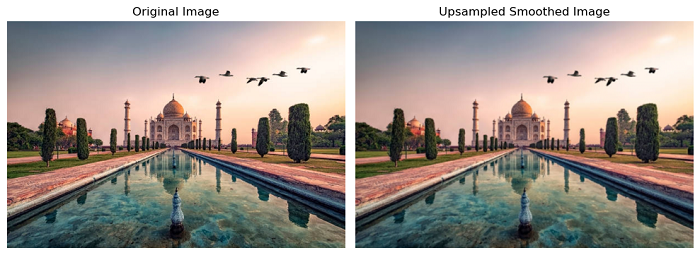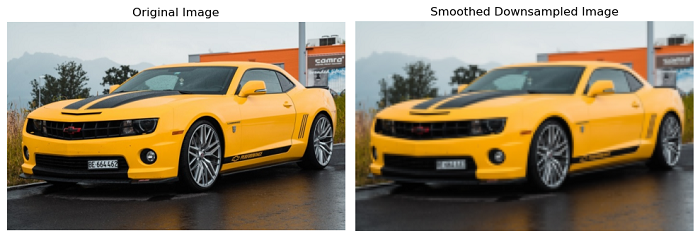
- Scikit Image – Introduction
- Scikit Image - Image Processing
- Scikit Image - Numpy Images
- Scikit Image - Image datatypes
- Scikit Image - Using Plugins
- Scikit Image - Image Handlings
- Scikit Image - Reading Images
- Scikit Image - Writing Images
- Scikit Image - Displaying Images
- Scikit Image - Image Collections
- Scikit Image - Image Stack
- Scikit Image - Multi Image
- Scikit Image - Data Visualization
- Scikit Image - Using Matplotlib
- Scikit Image - Using Ploty
- Scikit Image - Using Mayavi
- Scikit Image - Using Napari
- Scikit Image - Color Manipulation
- Scikit Image - Alpha Channel
- Scikit Image - Conversion b/w Color & Gray Values
- Scikit Image - Conversion b/w RGB & HSV
- Scikit Image - Conversion to CIE-LAB Color Space
- Scikit Image - Conversion from CIE-LAB Color Space
- Scikit Image - Conversion to luv Color Space
- Scikit Image - Conversion from luv Color Space
- Scikit Image - Image Inversion
- Scikit Image - Painting Images with Labels
- Scikit Image - Contrast & Exposure
- Scikit Image - Contrast
- Scikit Image - Contrast enhancement
- Scikit Image - Exposure
- Scikit Image - Histogram Matching
- Scikit Image - Histogram Equalization
- Scikit Image - Local Histogram Equalization
- Scikit Image - Tinting gray-scale images
- Scikit Image - Image Transformation
- Scikit Image - Scaling an image
- Scikit Image - Rotating an Image
- Scikit Image - Warping an Image
- Scikit Image - Affine Transform
- Scikit Image - Piecewise Affine Transform
- Scikit Image - ProjectiveTransform
- Scikit Image - EuclideanTransform
- Scikit Image - Radon Transform
- Scikit Image - Line Hough Transform
- Scikit Image - Probabilistic Hough Transform
- Scikit Image - Circular Hough Transforms
- Scikit Image - Elliptical Hough Transforms
- Scikit Image - Polynomial Transform
- Scikit Image - Image Pyramids
- Scikit Image - Pyramid Gaussian Transform
- Scikit Image - Pyramid Laplacian Transform
- Scikit Image - Swirl Transform
- Scikit Image - Morphological Operations
- Scikit Image - Erosion
- Scikit Image - Dilation
- Scikit Image - Black & White Tophat Morphologies
- Scikit Image - Convex Hull
- Scikit Image - Generating footprints
- Scikit Image - Isotopic Dilation & Erosion
- Scikit Image - Isotopic Closing & Opening of an Image
- Scikit Image - Skelitonizing an Image
- Scikit Image - Morphological Thinning
- Scikit Image - Masking an image
- Scikit Image - Area Closing & Opening of an Image
- Scikit Image - Diameter Closing & Opening of an Image
- Scikit Image - Morphological reconstruction of an Image
- Scikit Image - Finding local Maxima
- Scikit Image - Finding local Minima
- Scikit Image - Removing Small Holes from an Image
- Scikit Image - Removing Small Objects from an Image
- Scikit Image - Filters
- Scikit Image - Image Filters
- Scikit Image - Median Filter
- Scikit Image - Mean Filters
- Scikit Image - Morphological gray-level Filters
- Scikit Image - Gabor Filter
- Scikit Image - Gaussian Filter
- Scikit Image - Butterworth Filter
- Scikit Image - Frangi Filter
- Scikit Image - Hessian Filter
- Scikit Image - Meijering Neuriteness Filter
- Scikit Image - Sato Filter
- Scikit Image - Sobel Filter
- Scikit Image - Farid Filter
- Scikit Image - Scharr Filter
- Scikit Image - Unsharp Mask Filter
- Scikit Image - Roberts Cross Operator
- Scikit Image - Lapalace Operator
- Scikit Image - Window Functions With Images
- Scikit Image - Thresholding
- Scikit Image - Applying Threshold
- Scikit Image - Otsu Thresholding
- Scikit Image - Local thresholding
- Scikit Image - Hysteresis Thresholding
- Scikit Image - Li thresholding
- Scikit Image - Multi-Otsu Thresholding
- Scikit Image - Niblack and Sauvola Thresholding
- Scikit Image - Restoring Images
- Scikit Image - Rolling-ball Algorithm
- Scikit Image - Denoising an Image
- Scikit Image - Wavelet Denoising
- Scikit Image - Non-local means denoising for preserving textures
- Scikit Image - Calibrating Denoisers Using J-Invariance
- Scikit Image - Total Variation Denoising
- Scikit Image - Shift-invariant wavelet denoising
- Scikit Image - Image Deconvolution
- Scikit Image - Richardson-Lucy Deconvolution
- Scikit Image - Recover the original from a wrapped phase image
- Scikit Image - Image Inpainting
- Scikit Image - Registering Images
- Scikit Image - Image Registration
- Scikit Image - Masked Normalized Cross-Correlation
- Scikit Image - Registration using optical flow
- Scikit Image - Assemble images with simple image stitching
- Scikit Image - Registration using Polar and Log-Polar
- Scikit Image - Feature Detection
- Scikit Image - Dense DAISY Feature Description
- Scikit Image - Histogram of Oriented Gradients
- Scikit Image - Template Matching
- Scikit Image - CENSURE Feature Detector
- Scikit Image - BRIEF Binary Descriptor
- Scikit Image - SIFT Feature Detector and Descriptor Extractor
- Scikit Image - GLCM Texture Features
- Scikit Image - Shape Index
- Scikit Image - Sliding Window Histogram
- Scikit Image - Finding Contour
- Scikit Image - Texture Classification Using Local Binary Pattern
- Scikit Image - Texture Classification Using Multi-Block Local Binary Pattern
- Scikit Image - Active Contour Model
- Scikit Image - Canny Edge Detection
- Scikit Image - Marching Cubes
- Scikit Image - Foerstner Corner Detection
- Scikit Image - Harris Corner Detection
- Scikit Image - Extracting FAST Corners
- Scikit Image - Shi-Tomasi Corner Detection
- Scikit Image - Haar Like Feature Detection
- Scikit Image - Haar Feature detection of coordinates
- Scikit Image - Hessian matrix
- Scikit Image - ORB feature Detection
- Scikit Image - Additional Concepts
- Scikit Image - Render text onto an image
- Scikit Image - Face detection using a cascade classifier
- Scikit Image - Face classification using Haar-like feature descriptor
- Scikit Image - Visual image comparison
- Scikit Image - Exploring Region Properties With Pandas
Scikit Image - Image Pyramids
An image pyramid is a multi-scale representation of an image created by progressively downscaling or upscaling the original image. Each level of the pyramid represents the image at a different scale. It is a technique commonly used in computer vision and image processing for various tasks, including object detection, image recognition, and image compression.
The scikit-image library provides the functions called pyramid_reduce() and pyramid_expand() functions in the transform module to build and manipulate image pyramids.
Using the skimage.transform.pyramid_expand() function
The skimage.transform.pyramid_expand function is used to upsample and then smooth an input image.
Syntax
Following is the syntax of this function −
skimage.transform.pyramid_expand(image, upscale=2, sigma=None, order=1, mode='reflect', cval=0, preserve_range=False, *, channel_axis=None)
Parameters
- image (ndarray): Input image.
- upscale (float, optional): Upscale factor.
- sigma (float, optional): Sigma for Gaussian filter. Default is calculated as 2 * upscale / 6.0, which corresponds to a filter mask twice the size of the scale factor that covers more than 99% of the Gaussian distribution.
- order (int, optional): Order of splines used in interpolation of upsampling. See skimage.transform.warp for detail.
- mode (str, optional): Determines how the array borders are handled, where cval is the value when mode is equal to 'constant'.
- cval (float, optional): Value to fill past edges of input if mode is 'constant'.
- preserve_range (bool, optional): Whether to keep the original range of values. Otherwise, the input image is converted according to the conventions of img_as_float.
- channel_axis (int or None, optional): If None, the image is assumed to be a grayscale (single channel) image. Otherwise, this parameter indicates which axis of the array corresponds to channels. This parameter was added in version 0.19.
Return Value
It returns an array representing the upsampled and smoothed float image.
Example
Here are some examples of how to use the transform.pyramid_expand() function to upsample and smooth an image.
import numpy as np
import matplotlib.pyplot as plt
from skimage.transform import pyramid_expand
from skimage import io
# Load the input image
image = io.imread('Images/Tajmahal.jpg')
# Apply pyramid_expand function
upscale_factor = 2
upsampled_smoothed_image = pyramid_expand(image, upscale=upscale_factor, channel_axis=-1)
# Display the original and upsampled-smoothed images
plt.figure(figsize=(10, 5))
plt.subplot(1, 2, 1)
plt.imshow(image)
plt.title("Original Image")
plt.axis('off')
plt.subplot(1, 2, 2)
plt.imshow(upsampled_smoothed_image)
plt.title("Upsampled Smoothed Image")
plt.axis('off')
plt.tight_layout()
plt.show()
Output
On executing the above program, you will get the following output −

Using the skimage.transform.pyramid_reduce() function
The skimage.transform.pyramid_reduce function is used to smooth and then downsample an input image.
Syntax
Following is the syntax of this function −
skimage.transform.pyramid_reduce(image, downscale=2, sigma=None, order=1, mode='reflect', cval=0, preserve_range=False, *, channel_axis=None)
Parameters
- image (ndarray): Input image.
- downscale (float, optional): Downscale factor.
- sigma (float, optional): Sigma for Gaussian filter. Default is calculated as 2 * downscale / 6.0, covering more than 99% of the Gaussian distribution.
- order (int, optional): Order of splines used in interpolation of downsampling. Refer to skimage.transform.warp for details.
- mode (str, optional): Determines how the array borders are handled. cval is the value when mode is 'constant'.
- cval (float, optional): Value to fill past edges of input if mode is 'constant'.
- preserve_range (bool, optional): Whether to keep the original value range. If False, the input image is converted according to img_as_float conventions.
- channel_axis (int or None, optional): Indicates which axis of the array corresponds to channels. If None, the image is assumed to be grayscale (single channel). This parameter was added in version 0.19.
Return Value
It returns a ndarray which represents the smoothed and downsampled float image.
Example
Here are some examples of how to use the transform.pyramid_reduce() function to smooth and then downsample an image.
import numpy as np
import matplotlib.pyplot as plt
from skimage.transform import pyramid_reduce
from skimage import io
# Load the input image
image = io.imread('Images/Yellow Car.jpg')
# Apply pyramid_reduce
smoothed_downsampled_image = pyramid_reduce(image, downscale=4, order=5, channel_axis=-1)
# Display the original and smoothed-downsampled images
plt.figure(figsize=(10, 5))
plt.subplot(1, 2, 1)
plt.imshow(image)
plt.title("Original Image")
plt.axis('off')
plt.subplot(1, 2, 2)
plt.imshow(smoothed_downsampled_image)
plt.title("Smoothed Downsampled Image")
plt.axis('off')
plt.tight_layout()
plt.show()
Output
On executing the above program, you will get the following output −
